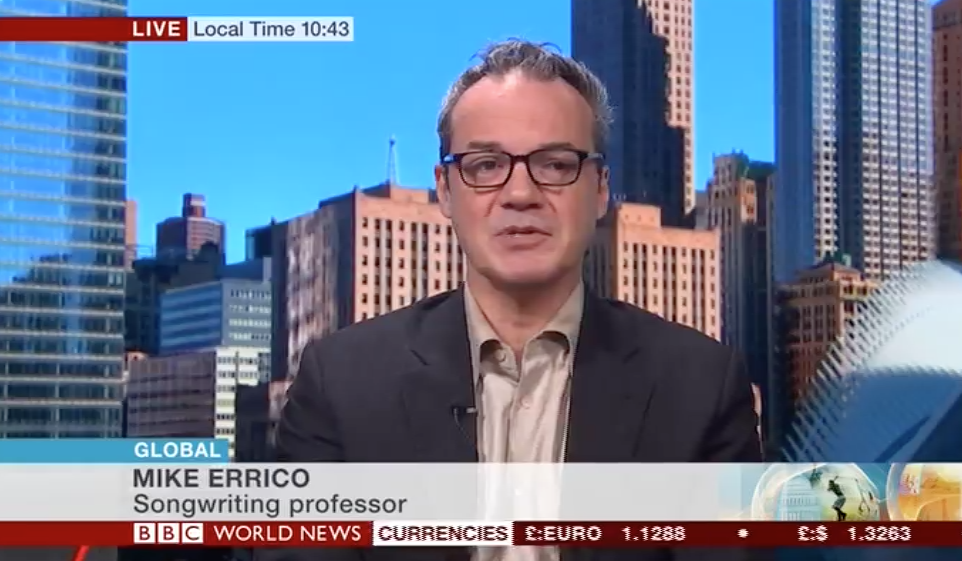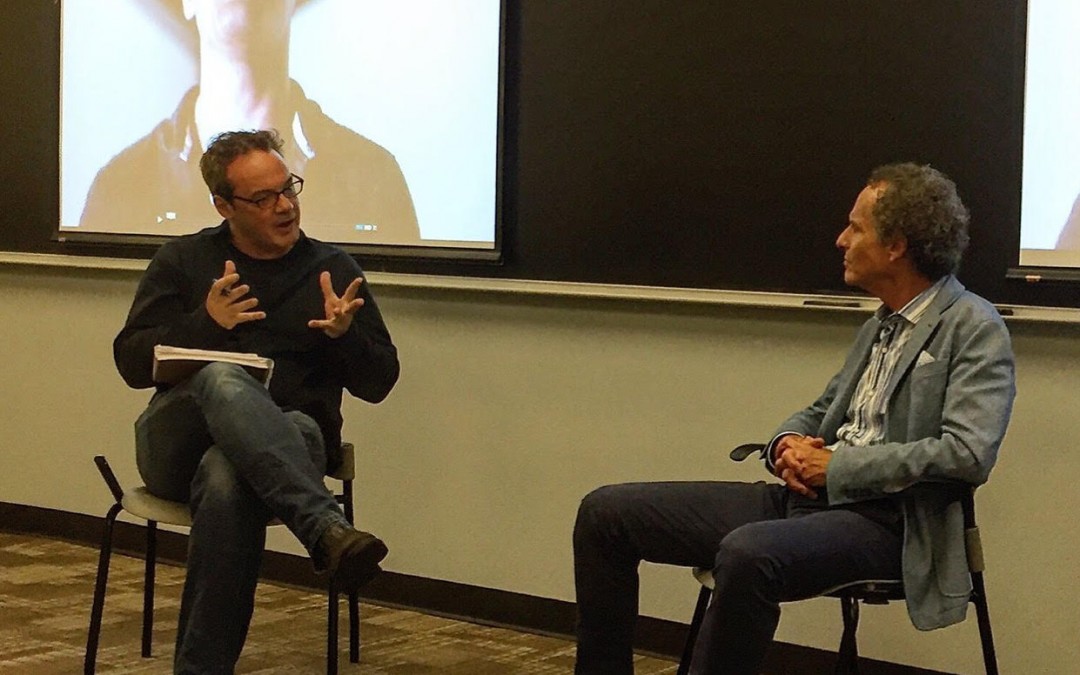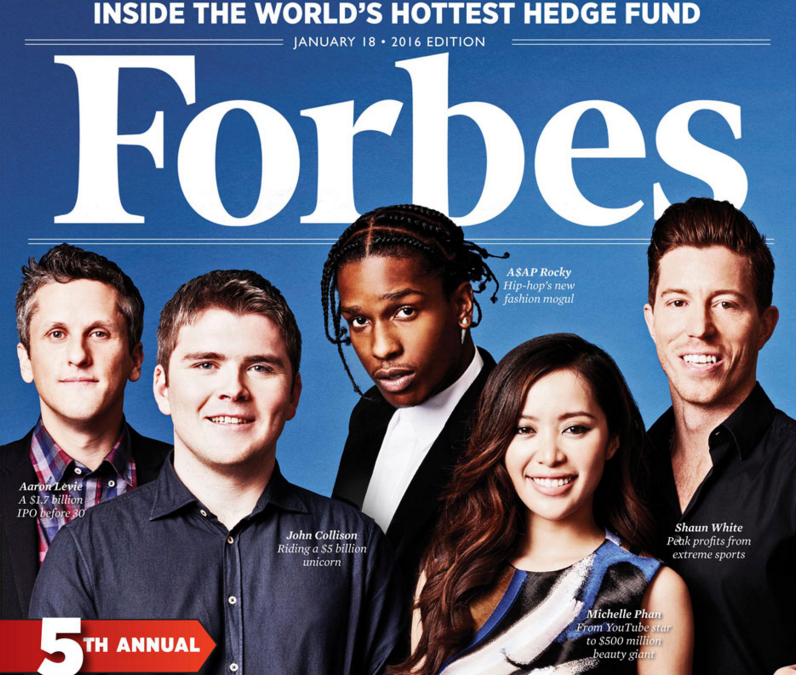
by Mike Errico | Oct 12, 2017 | live shows, Photo, Teaching
Good times w/ The BBC (@bbcnews) discussing why we don’t have long song intros like “Hotel California” anymore, but we do have 8-hour-long compositions you’re meant to sleep through. Confusing times, these. I’m trying to make sense of it myself. “No one does rumpled like you, Errico…” — a friend. I don’t think I look rumpled. Do I? The ‘no tie’ was a choice, and a recommendation, and I think it was a good call. No? I sat in a room in NY while this was going on in the UK. I’d never done that before. Very disembodied. Very Max Headroom. Since I was alone, had to take a selfie in the monitor. Probably could have looked at the monitor, too. Now it looks like I’m checking my Instagram. All rumpled. (See above.) Anyway, it was cool. Thanks to the BBC for calling me. (They really did call me. I know. I was surprised, too.) I hope I shed some light on what is basically a totally open-ended future. For those unaware of my teaching side, here’s the spiel from NYU: New York-based musician, writer, and lecturing professor, Mike Errico has built his name on the strength of critically acclaimed releases and extensive composition for film and TV. He has taught songwriting at Yale and Wesleyan universities, and speaks about the art and business of songwriting at colleges, high schools, and conferences across the country. Live, Errico has toured the country for over a decade, playing major music festivals and sharing stages with artists including Raul Midon, Jonny Lang, Soulive, Bob Weir, Amos Lee, Ben Folds, Dan Wilson, Derek...

by Mike Errico | Jun 25, 2016 | Photo, Teaching
Daniel Glass, founder of Glassnote Records, joined me at NYU’s Clive Davis Institute of Recorded Music to speak to my students about the (bright!) future of the music industry. Photo by Glassnote recording artist/former student Tor Miller (pictured behind us. Look for a big announcement from him in the coming...

by Mike Errico | Feb 10, 2016 | Teaching, Text Journalism
Los Angeles: I’ll be speaking (and playing) about food, design, and music alongside foodies from KCRW, Gizmodo, and the Union of Concerned Scientists, as well as Mark Bittman, Jessica Helfand, Michael Beirut, and many more. There will be food. There will be thought. I got pesto sauce in my bag. #swag Agrarian economics. Dry farming. Engineered waste. Vaporized nutrition. How are any of these things a function of design? On the other hand: how could they be anything else? On February 12, 2016, Design Observer will host a symposium on the relationship between design and food. Held in the Los Angeles Theater Center, Taste will feature speakers from across the United States and Europe: we’ll hear from a historian who has traced the origins of artificial flavor; an engineer who has discovered how to nebulize nutrients; and a politician lobbying for national food security. We’ll look at marketing tactics and distribution platforms; climate change and culinary excess; new economies of scale, old expressions of culture—and everything in between. We’ll eat, drink, and be merry, while raising critical questions about where the future of food is headed. TICKETS ON SALE...

by Mike Errico | Feb 7, 2016 | Teaching, Text Journalism
Thanks to Billboard for adding me to their piece, Album of 100 Songs, All 30 Seconds Long, Holds Digital Music and Modern Life Over the Coals. This summer, New York University songwriting professor Mike Errico wondered, darkly: “Spotify, the clear leader in the streaming space, pays after 30 seconds, so an honest question is… why write beyond that?” Mark Christopher Lee got the joke, and took it very seriously indeed. Six days ago he uploaded 100×30, a record of 100 songs each a hair over 30 seconds long, to SoundCloud. No industry participant is spared. A short list of 100×30’s targets include: Spotify, YouTube, Shazam, Deezer, the Brit Awards, the BBC, MP3s, SoundCloud, sync deals, The Orchard, Sony Music, NME, Starbucks, Noel Gallagher, Steve Jobs and MacBooks. Speaking to Errico via The Independent, Lee says: “I’ve been trying to have a meaningful debate about how we value music, and how we pay for it.” Mostly, however, his focus seems to be on how we don’t pay for it. Read on at Billboard Some Billboard – related pieces include: “Touring Can’t Save Musicians in the Age of Spotify” (New York Times) Appearance on CNN to discuss “Musicians Struggling Through the Streaming Age” What the Blues Can Teach You About Life, Art, and Everything In-Between (The Observer) “Space Oddity” and the Power of the Story Song (Cuepoint) Is the Three-Minute Pop Song Over? (The Independent UK) Hi. I’m Your Songwriting Professor. (The Observer)...

by Mike Errico | Feb 7, 2016 | Teaching, Text Journalism
Forbes, the business magazine, has posted The Uneasy Future Of Format Innovation In Music Streaming. It has a good riff on the thirty-second song pieces I did, as well as other prognostications on how technology will influence artists and art. Only a few weeks before MIDiA released its report on variable media programming, musician Mark Christopher Lee released the album 100 x 30, which consists of 100 songs each only 30 to 39 seconds long. The album was a response to a June 2015 op-ed in The Independent by Mike Errico, adjunct professor of songwriting at New York University, who argued that Spotify’s royalty payout for tracks after just 30 seconds of streaming provides a financial incentive for artists to post shorter songs on the service. More than simply profitability, however, Lee aimed simply to propagate Errico’s statement on how the impact of streaming on the music industry can potentially lead to an overbearing hunger for creative efficiency. In fact, a quick glance at 100 x 30’s track titles, ranging from “How Many Friends Have You Bought in Your Unsigned Band” to “EMI (Eat My Industry),” confirms that the album is a harshly calculated stab at the increasing digitization of the music industry as a whole. Pieces related to the Forbes article include: “Touring Can’t Save Musicians in the Age of Spotify” (New York Times) Appearance on CNN to discuss “Musicians Struggling Through the Streaming Age” Is the Three-Minute Pop Song Over? (The Independent...

by Mike Errico | Jan 20, 2016 | Teaching, Text Journalism
Exploring the brilliant techniques Bowie used to populate his Major Tom saga In my songwriting classes, I assign a week where the students are to write a “story song” — a piece of music with a character that develops and takes us on a journey of some sort. The students generally look at me cross-eyed. Once, upon hearing the assignment, a student asked, “You mean, like…Meatloaf?” To which another asked, “Who’s Meatloaf?” A third cleared things up by offering, “No, he means kinda like ‘Stan,’” referring to the Eminem song from their distant collective childhoods. Yes. Like “Stan.” At the moment, songs — and I’m generalizing, though popular charts do bear this out — tend to hone in on a particular moment and expand upon a fixed sensation. For instance, Adele’s “Hello,” the most popular song at the time of this writing, pushes out from a personal phone call to reveal her anguish over a past relationship. Songs with a wider lens use the first person plural (“we”) and are addressed directly to audience members in hopes of generating a rallying cry — the all-powerful “anthem.” (Fun’s 2011 hit “We Are Young” comes to mind.) EDM and electronic genres sidestep the whole concept of story by either eliminating lyric completely, or relegating a vocal part to a sampled and repeated hook. In this case, the music serves as a personal soundtrack that can be interpreted in ways that are not limited by language. Its inherent vagueness allows it to scale as others fill it with meaning, as if it were the audio version of Facebook. None of this is...







